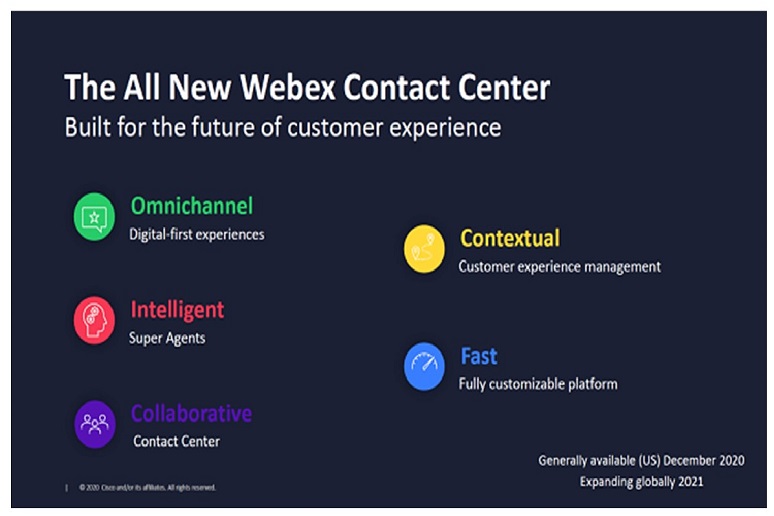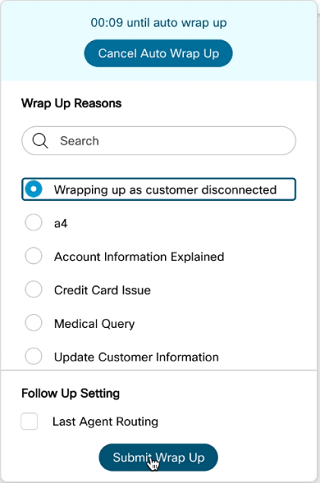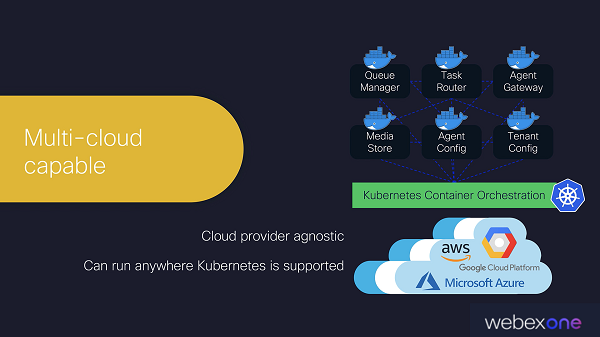As I described in a February
post, an important decision Cisco Collaboration faced in 2019 was whether to build or buy on cloud contact center. As is often true in business, the ultimate decision combined both strategies, and Cisco is sharing details as part of its
WebexOne event, a virtual coming-out party for the new Webex Contact Center solution.
The Build
In an analyst pre-briefing, Javed Khan, SVP and GM of Cisco Collaboration, spoke frankly about Cisco’s need to show more progress innovating its contact center portfolio. “We were trying to take a stack that was built for a hosted environment and place it in the cloud,” Khan told analysts.
What Omar Tawakol, VP and GM for Cisco Contact Center, and his team have been doing quietly for the past few months, “with hundreds of engineers,” reported Khan, is building a pure, cloud-native contact center. “If we were a startup, how would we build this?” became the approach.
The Buy
As discussed yesterday
on No Jitter, Cisco announced its intention to
acquire U.K.-based IMImobile. In a briefing, Tawakol and Vinod Muthukrishnan, chief growth officer for Cisco’s contact center business unit, described how Cisco will integrate the acquisition’s assets into what it has been building internally. Note that this acquisition is not scheduled to complete until March 2021, so the features attributable to that integration will likewise not be available immediately.
“At the highest level, we want to make it easy for consumers to message to a business, similar to how they message to a friend. That's certainly not the case today,” Tawakol said. “Cisco had been very voice-centric, and we wanted to do something big to catch up with the changes happening in the market,” he added.
IMImobile brings two important capabilities for helping transform Webex Contact Center into a digital-first platform. First is the long list of messaging channels with which it has built integrations. This list includes text, Apple Business Chat, WeChat, WhatsApp, and more. The second is a low-code, no-code orchestration tool, which IMIMobile calls a flow builder, that can automate the creation of customer journeys quickly using a drag-and-drop editor. The goal is to allow a business operations person to create business flows, without needing IT’s assistance.
The new WebEx Contact Center platform, with built and acquired assets, has five pillars, as shown in the image above and described below.
Omnichannel
An agent inbox for all interactions, whether they're coming through the phone, SMS, email, Facebook Messenger, Twitter, or any other channel, is elemental for delivering a digital-first experience, Tawakol said. The agent needs to be able to address any of these interaction types in one place. As a company, you need to be able to orchestrate across all your agents in one system. Earlier versions of Webex Contact Center relied on partner solutions to deliver a full omnichannel experience. Once the IMImobile acquisition is complete, omnichannel will be an in-house capability.
Artificial Intelligence (AI), principally in the form of chatbots and voicebots, found wider
acceptance in 2020 than previously. That said, a proportion of calls that begin in a bot eventually need human assistance. Webex Contact Center offers a number of features for delivering context from the virtual bot to the agent. It also has a feature that allows AI to listen to the conversation, and using various modeling techniques, understand a caller’s intent. It then surfaces a knowledgebase article or a nudge that shows the agent problem resolution in a previous and similar case.
The agent should be able to solve the problem without putting the consumer on hold — meaning, quicker time to resolution. Once the agent finishes the call, the AI offers an automated wrap up of the call, as shown in the graphic. Agents select the correct call category, and move on to the next call. Agent Call Transcripts, for call wrap-up, and Agent Answers, for turn-by-turn guidance, are “coming in 2021.”
Collaborative Contact Center
For the new Webex Contact Center agent desktop, Cisco took inspiration from applications like SnapChat and WhatsApp that agents use outside of work, Tawakol said. “Agents expect a simple user interface (UI) that serves their needs, that gives them the omnichannel experience, and really maps out the customer's full journey, so that they can get to the data they want to solve the customer’s problem and do it with speed,” he explained.
Cisco has built the new Webex Contact Center agent desktop on the same user interface design platform and aesthetic as the rest of the Webex portfolio, allowing support for complimentary Webex messaging and meetings tools that will allow agents to engage with subject matter experts. The current Cisco Contact Center Finesse desktop dates to 2010; while it has been updated over the years, it’s been long overdue for a cloud-native upgrade.
Contextual
Especially in a digital-first world, nobody comes to the contact center to complain about the contact center, Tawakol said. They come because something somewhere else in the journey didn't go well. Something went wrong. Solving the problem involves treating each interaction as part of a larger journey, a concept that is not necessarily new but not easily solved.
Cisco posits that the answer is analytics. Analytics give a company the ability to solve not just a particular problem but understand if dozens of other customers have the same issue. Cisco addresses the issue by integrating the
CloudCherry application, acquired in late 2019 and now called Webex Experience Management, into the Webex CCaaS solution, Tawakol said.
Webex Experience Management tools are now embedded into Webex Contact Center, delivering journey sentiment scores, real-time surveys, journey analytics, and an executive dashboard.
Fast
Fast refers to the fully customizable nature of the new Webex Contact Center platform. Some of that customization capability will come from the flow builder that IMImobile will bring to the party post-acquisition. But much of it is being delivered internally, by Ryan Plant, CTO, and Sridhar Gadipatti, director of software engineering, of the Cisco contact center business unit, and their teams. Think of those hundreds of engineers that Khan referenced above.
I won’t pretend to be able to tell the full story of what Plant has done. Instead let me tease you with this graphic, below, showing the next-generation platform powering the new Webex Contact Center. Plant will explain all of this in detail during a
WebexOne session today at 1:10 p.m. EST, but for now:
Speed refers to a public cloud solution that can deliver microservices-based updates continuously versus the annual or at best quarterly updates that Cisco has delivered in the past.
Today, Cisco reports that it has 36,000 customers and over three million agent licenses, primarily on-premises or hosted solutions. Some of these customers have tens of thousands of agents deployed on Cisco. When asked if the new Webex Contact Center is designed as a potential cloud migration product for all these customers, Tawakol answered “Yes,” unequivocally. “The platform is horizontally scalable,” Tawakol said. “It will need to be tested at very high agent levels, in real-world scenarios, but it has been designed to meet the needs of even the largest Cisco contact center customer.”











